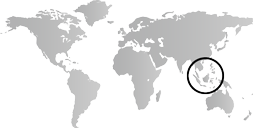Excavations of sites in Vietnam and Thailand reveal that early Neolithic cultures here produced flaked stone tools and ceramics with pressed decoration. These nomadic peoples begin to establish agricultural settlements along the coastline where the soil is especially rich. Shells become an important medium of exchange.
Extending southward from Burma (Myanmar) to the Indonesian archipelago, the largest island complex in the world, Southeast Asia is an area of anthropological and archaeological complexity. Four major language groups—Austroasiatic, Austronesian, Tibeto-Burman, and Tai-Kadai—are spoken in the region, which is home to many different cultures and peoples. For the sake of clarity, the names of modern nations are used in this timeline to indicate geographic locations. However, it should be noted that scholarship on the early material culture of this area (which encompasses thousands of archaeological sites) focuses on regional groupings rather than national boundaries. Finally, terms such as Neolithic and Bronze Age, based on the study of early West Asia, are used here primarily as points of reference (lacking any other widely accepted terminology) and not as exact parallels to the developmental sequence elsewhere.
